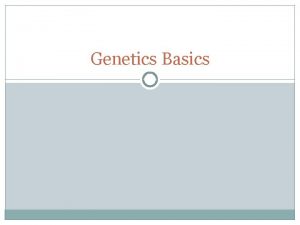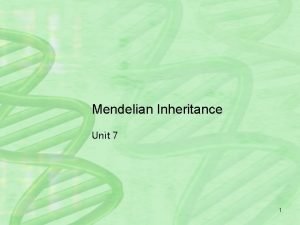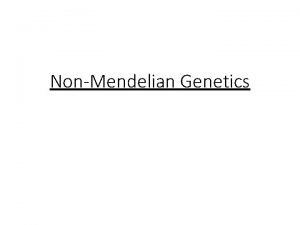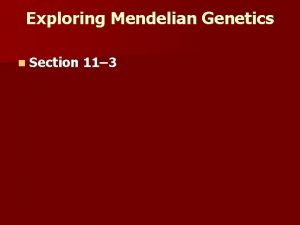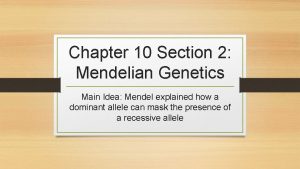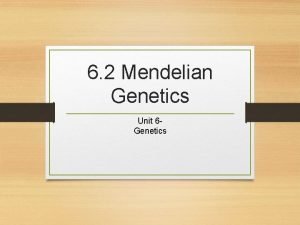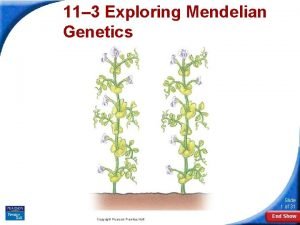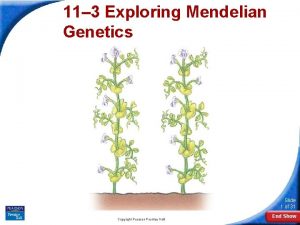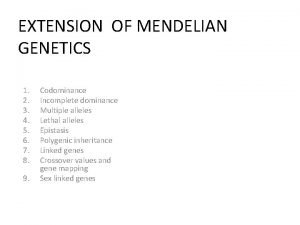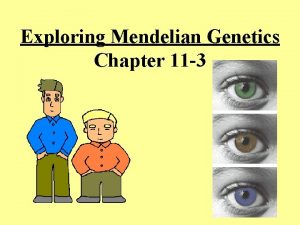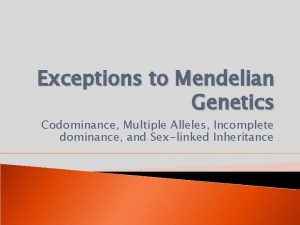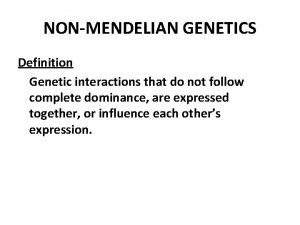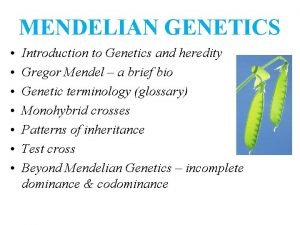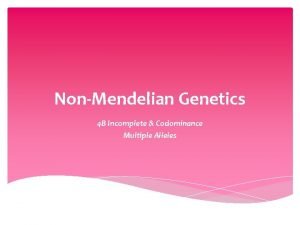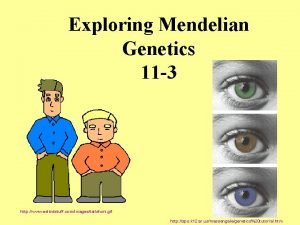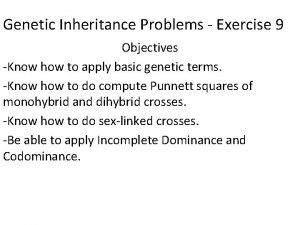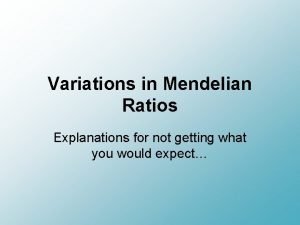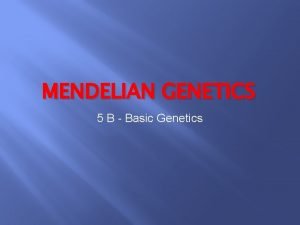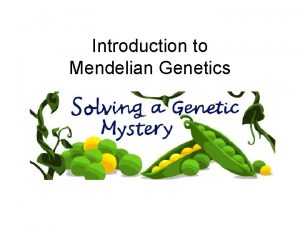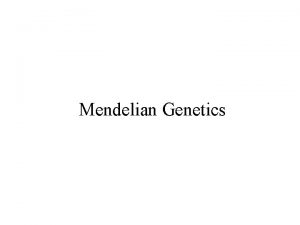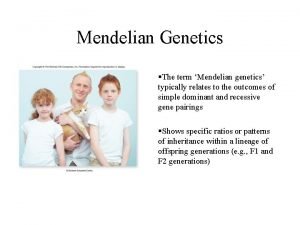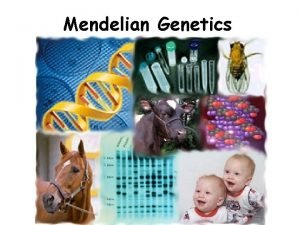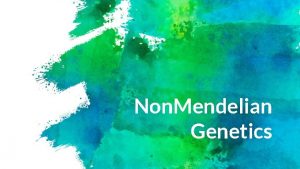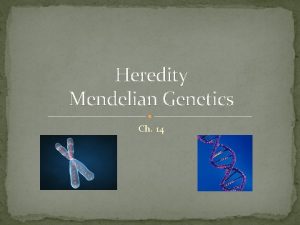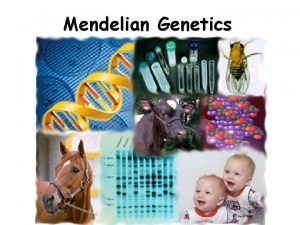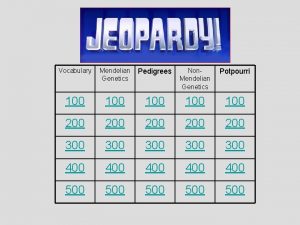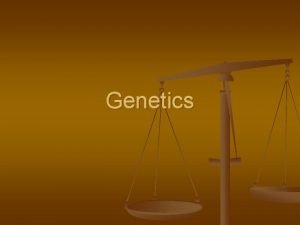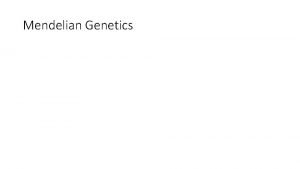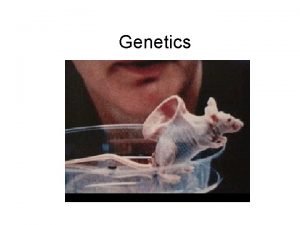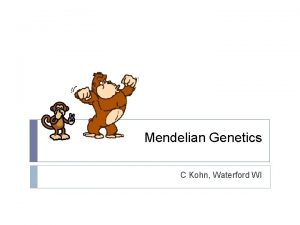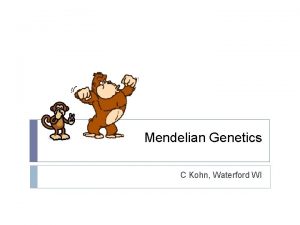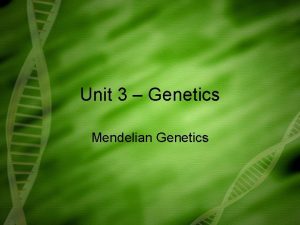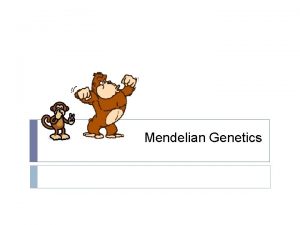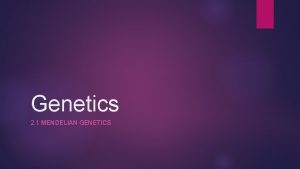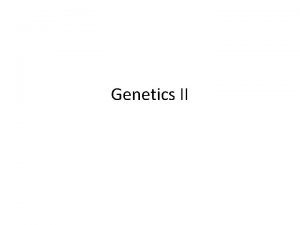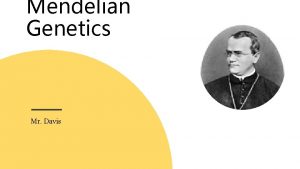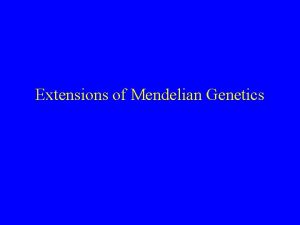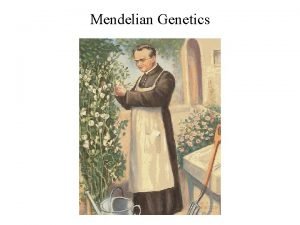Introduction to Mendelian Genetics In The Simplest Terms





























- Slides: 29

Introduction to Mendelian Genetics In The Simplest Terms I Can Think Of

All living things have observable traits. We call these observable characteristics a phenotype.

Living things usually have two genes that determine each trait. This corresponds with the fact that most living things have two parents – or at least both male & female parts.

We represent these genes with letters – capital or lower case – but use the same letter for each trait. It doesn’t really matter which letter you use – as long as you use the same letter for each trait.

• You will use an upper case letter if the trait is dominant (A) • You will use a lower case letter if the trait is recessive (a) • The upper & lower case forms of the letter represent different gene forms or alleles.

Remember, you have two genes for each trait so there are three possible combinations: AA or Aa or aa When we write the letters like this we call it a genotype.

Whenever the dominant gene is present in the genotype, the dominant phenotype is observed. (AA or Aa) The only way to observe a recessive phenotype is to have two recessive genes together in the genotype. (aa)

If you have two of the same “case” (upper or lower) in a genotype it is considered homozygous or pure. If you have two different “case” (upper & lower) in the genotype it is considered heterozygous or hybrid.

For Example: Let’s say that on planet X blue hair is dominant to yellow hair. • How did you know which was dominant or recessive? I had to tell you that. • So we need to assign some letters to the genes: • Again, it doesn’t matter what letter you use. A lot of times a letter is chosen based on the dominant trait. • B = blue b = yellow • DO NOT PUT A “Y” FOR YELLOW - YOU HAVE TO USE THE SAME LETTER FOR EACH DIFFERENT TRAIT! • So let’s say that a homozygous blue boy being mates with a homozygous yellow female. • First you have to think – what are their genotypes? homozygous blue = BB homozygous yellow = bb

Then we can make a Punnett square to demonstrate the cross in an easy to observe form. • Each parent will give one gene (letter) to a potential offspring • Put the female genes (letters) above each of the top squares. In this case she can give a “b” or “b” • Put the male genes (letters) along the left side. In this case he can give a “B” or “B” • Then fill in the boxes for the possible combinations b b B Bb Bb

So there is only one possible genotype for this combination: All offspring (100% or 4/4) will be Bb. All (100% or 4/4) will have a “blue hair” phenotype since even though they are hybrid, they carry the dominant gene which will mask the recessive trait.

Let’s take it one step further… • Let’s say that two of the blue hairs from our F 1 generation mate – because that is okay on planet X. • Both have the genotype Bb – they can give either a “B” or “b” to the potential offspring. B • Let’s set up another square to see what type of offspring they might have: b • In this case, there are three possible genotypes of offspring: 1/4 (25%) BB, 2/4 (50%) Bb, 1/4 (25%) bb • The phenotype ratios are: 3/4 blue (3 have a “B”) and 1/4 yellow. B b BB Bb Bb bb

Both of the above examples are referred to as a monohybrid crosssince we only studied one trait-hair color.

Here’s something you may have noticed: there are only two phenotypes, but three possible genotypes.

How could you determine if something showing a dominant trait is homozygous (BB) or heterozygous (Bb)? • A surefire method would be to cross the thing in question with a thing showing the recessive trait – because you know its genotype: bb – they are always homozygous recessive. This is called a TEST CROSS. • If you get all things showing a dominant trait, the organism was probably homozygous (BB) – and the offspring are heterozygous (Bb) • If you get any things showing the recessive trait (bb) it had to be a hybrid (Bb) since it had to have had a recessive gene to pass on the homozygous recessive offspring.

Here are some sample problems:

1. On planet X, blue hair is dominant to yellow hair. A heterozygous blue hair mates with a yellow hair. • a. Give the genotypes for the two things being crossed: • Bb X bb • b. Make a Punnett square to show the cross. • c. Give the probabilities of the percentages of genotypes & phenotypes in offspring. • 50% Bb, 50% bb; 50% blue, 50% yellow B b b Bb bb

2. On planet X, a blue haired male mates with a yellow haired female. They have a child with yellow hair. What then, must the genotype of the father be? • The father must be Bb to have passed on a recessive gene but still show the dominant trait.

3. On planet X, what 3 combinations of parent genotypes could have a child with yellow hair? *both parents must carry a “b” to pass to offspring • Bb x Bb • bb x bb • Bb x bb

4. In a certain animal, black fur (B) is dominant to white fur (b). Determine the expected genotypic ratios & phenotypic ratios resulting from crosses between: B • homozygous black x white b Bb Bb • two heterozygous blacks • heterozygous black x white B B b b Bb bb B BB Bb bb

5. Which of the following genotypes are heterozygous: • • • AA Aa Yy yy Rr RR no √ √ no

6. Round (R) is dominant shape for seeds of pea plants. Wrinkled (r) is recessive. What are the phenotypes for the following allele pairs: • RR • Rr • rr round wrinkled

7. In a plant with genotype Rr for seed shape, what percentage of the gametes will have the • R allele? 50% • r allele? 50%

8. If the gene for freckles (F) is dominant over the gene for no freckles (f), what are the possible genotypes of the parents of a child who does not have freckles? • For a child not to have freckles, both parents must have the “f” allele. • Ff x ff, ff x ff, Ff x Ff

9. In human beings, brown eyes (B) are dominant over blue eyes (b). Suppose a blue eyed man marries a brown eyed woman whose father was blue eyed. What proportion of their children would you predict would have blue eyes? • We know the man is bb if he shows the recessive trait. • If the woman’s father had blue eyes he had to have passed a “b” to her so her genotype must be Bb • 50% should have blue eyes B b b Bb bb

Monohybrid Cross Worksheets Frog Book

BB Bb Bb bb b B Bb b Bb Bb b B Bb b bb b Bb bb 25 50 25 75 25 0 100 0 0 50 50

Dihybrid Cross Frog Worksheet

b. E be Bb. Ee. Bbee bb. Ee bbee To find the possible gamete combinations use FOIL 25 Bb. Ee BE Be b. E be BE BBEe Bb. EE Bb. Ee Be BBEe BBee Bb. Ee Bbee b. E Bb. Ee bb. EE bb. Ee be Bb. Ee Bbee bb. Ee bbee 9 3 3 1 6. 25
 Carrier female genotype
Carrier female genotype Difference between mendelian and non mendelian inheritance
Difference between mendelian and non mendelian inheritance Is baldness a sex linked trait
Is baldness a sex linked trait Section 11-5 linkage and gene maps answer key
Section 11-5 linkage and gene maps answer key Extending mendelian genetics
Extending mendelian genetics Section 11-3 exploring mendelian genetics
Section 11-3 exploring mendelian genetics Chapter 10 section 2 mendelian genetics
Chapter 10 section 2 mendelian genetics Mendel was a
Mendel was a Section 11-3 exploring mendelian genetics answers
Section 11-3 exploring mendelian genetics answers Section 11-3 exploring mendelian genetics
Section 11-3 exploring mendelian genetics Holandric genes
Holandric genes Pprr x pprr punnett square
Pprr x pprr punnett square Section 11-3 exploring mendelian genetics answer key
Section 11-3 exploring mendelian genetics answer key Hors xnxn
Hors xnxn Extending mendelian genetics
Extending mendelian genetics What is incomplete dominance simple definition
What is incomplete dominance simple definition Co dominance
Co dominance 3 laws of inheritance
3 laws of inheritance Chapter 10 sexual reproduction and genetics
Chapter 10 sexual reproduction and genetics Purebred vs hybrid
Purebred vs hybrid The scientific study of heredity *
The scientific study of heredity * Multiple alleles
Multiple alleles Carrier female genotype
Carrier female genotype Heredity concept map
Heredity concept map Mendelian genetics vocabulary
Mendelian genetics vocabulary 11-3 exploring mendelian genetics
11-3 exploring mendelian genetics Basic terms in genetics
Basic terms in genetics Polynomial classification
Polynomial classification Like terms in algebra
Like terms in algebra Mendelian ratios
Mendelian ratios
